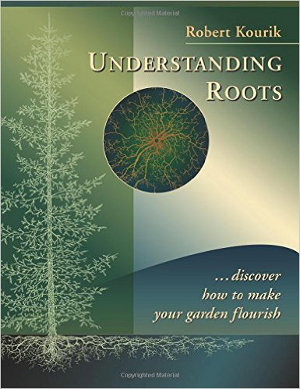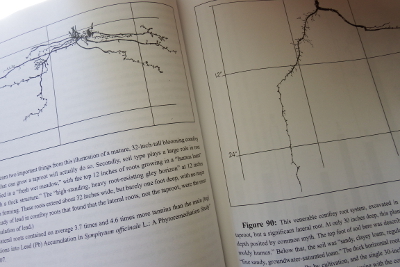
Understanding Roots
 Robert Kourik recently sent me a review copy of his newest book, Understanding Roots,
and I highly recommend it...for about 30% of our readers. Those of you
who love my geekiest posts, who aren't afraid of numbers, and who are
willing to read critically (Jake, I'm looking at you) will find Understanding Roots
both intriguing and thought-provoking. On the other hand, readers who
come here for the pretty pictures and whose eyes glaze over when I start
rambling on at length should probably skip this one.
Robert Kourik recently sent me a review copy of his newest book, Understanding Roots,
and I highly recommend it...for about 30% of our readers. Those of you
who love my geekiest posts, who aren't afraid of numbers, and who are
willing to read critically (Jake, I'm looking at you) will find Understanding Roots
both intriguing and thought-provoking. On the other hand, readers who
come here for the pretty pictures and whose eyes glaze over when I start
rambling on at length should probably skip this one.
If you've read some of Kourik's other books,
you'll know that the author has an intellectual crush on Dr. John
Weaver, who spent his entire career excavating soil to draw meticulous
maps of plants' roots in Nebraska. While Understanding Roots does
include many additional Weaver root maps, though, Kourik delved a
little deeper this time around and included drawings from other sources
as well. This is handy since the German scientists he tracked down, for
example, generally found much shallower roots for the same species of
plants compared to those Weaver drew. This shouldn't be entirely
surprising --- the deep soil of the Great Plains makes it much easier
for roots to delve deep, so those of us with poorer soil will likely be
dealing with considerably shallower roots than those shown in Kourik's
previous books.
Another intriguing point from Understanding Roots pertains to dynamic accumulators.
We've all heard the stories --- comfrey roots extend many feet into the
ground and suck up leached nutrients, which they return to the soil
surface for the use of other plants. But how true are the stories?  Kourik
assessed the data and discovered that most dynamic accumulators merely
concentrate nutrients from the topsoil, using deep roots (if present) to
search for water during droughts. In fact, the vast majority of comfrey
roots are found in the top foot of soil just like the roots of most
other plants. This is where the nutrients are highest, oxygen is most
plentiful, and beneficial microorganisms proliferate.
Kourik
assessed the data and discovered that most dynamic accumulators merely
concentrate nutrients from the topsoil, using deep roots (if present) to
search for water during droughts. In fact, the vast majority of comfrey
roots are found in the top foot of soil just like the roots of most
other plants. This is where the nutrients are highest, oxygen is most
plentiful, and beneficial microorganisms proliferate.
In the end, Kourik's book
is bountifully illustrated and full of sound science. But it's
definitely a text for the thinking gardener to curl up with in front of
the wood stove during a long winter night rather than a how-to manual to
inspire you to dive into the summer garden. So pick up this book only
if you're looking for a thought-provoking text to help you reach the
next level as a permaculture gardener.
Want more in-depth information? Browse through our books.
Or explore more posts by date or by subject.
About us: Anna Hess and Mark Hamilton spent over a decade living self-sufficiently in the mountains of Virginia before moving north to start over from scratch in the foothills of Ohio. They've experimented with permaculture, no-till gardening, trailersteading, home-based microbusinesses and much more, writing about their adventures in both blogs and books.
Want to be notified when new comments are posted on this page? Click on the RSS button after you add a comment to subscribe to the comment feed, or simply check the box beside "email replies to me" while writing your comment.

Ken --- So glad I could help!
De --- That's a good question. I'd probably have to say no, although there were some interesting tidbits that supported my existing techniques. For example, he found that oat roots are some of the most extensive of the grain cover crops and oilseed radishes seem to make more phosphorus available in the top six inches of soil. But I already love both of those cover crops, so I didn't need to be sold on them again.
Hello! I just saw this page and I really hope it is still active. I would really like to use the book as a reference. But I have to write my text in a week and I live in Belgium so the book will never arive in time. My question is if u could tell me on which page he cites that deep roots don't always take up nutrients from deeper layers, but often use it as nutrient storage etc. This would help me a lot! It is for my bachelor paper about Comfrey and it's use in a food forest! Thank u in advance!